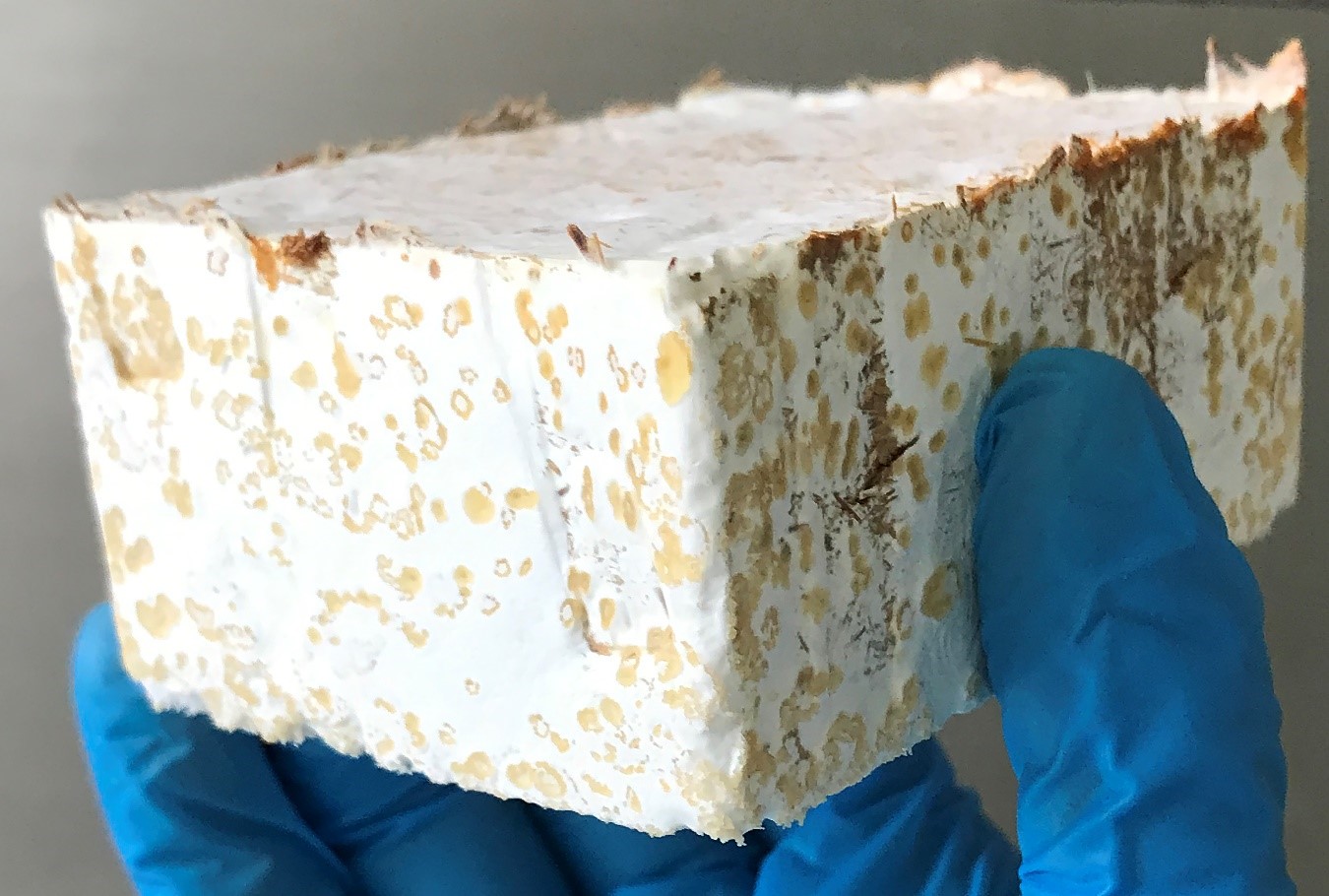Biomaterials based on mycelium: biotabique prototype from the Bajío region of Mexico
DOI:
https://doi.org/10.37636/recit.v7n3e346Keywords:
Biomaterials, Bioarchitecture, Bioconstruction, MyceliumAbstract
Mycelium-based biomaterials are the result of cultivating fungi in organic materials, such as agricultural waste. This presents a promising alternative for developing new materials. Our study focuses on developing biobrick using mycelium prototypes and agricultural organic waste, specifically straw from crops in León, Guanajuato. We found that factors like light, humidity, and temperature conditions can influence the development of the biomaterial. Additionally, the drying process of the biomaterial, also be taken into consideration.
Downloads
References
CONABIO, "La biodiversidad en Guanajuato: Estudio de Estado," Comisión Nacional para el Conocimiento y Uso de la Biodiversidad (CONABIO)/Instituto de Ecología del Estado de Guanajuato (IEE), México, 2012.
D. Alvarado-Rosales, L. L. Saavedra-Romero, and A. Almaraz-Sánchez, "Agentes Asociados y su Papel en la Declinación y Muerte de Encinos (Quercus fagaceae) en el Centro-Oeste de México" pp. 1-21, 2007.
R. L. Gilbertson, K. J. Martin, and J. P. Lindsey, "Annotated Check List and Host Index for Arizona Wood-Rotting Fungi," CALS Publications Archive. The University of Arizona, 1974. https://repository.arizona.edu/handle/10150/602154.
SDAyR, "Diagnóstico Agrologístico del Estado de Guanajuato," 2021. https://sdayr.guanajuato.gob.mx/contenido/adjuntos/evaluaciones/2020/DIAGNOSTICO_AGROLOGISTICO_DEL_ESTADO_DE_GUANAJUATO.pdf.
M. Ahmad, Z. Y. Zhou, and H. Li, "Revealing stylized empirical interactions among construction sector urbanization energy consumption economic growth and CO2 emission in China," Science of The Total Environment, vol. 657, pp. 1085-1098, 2019. https://doi.org/10.1016/j.scitotenv.2018.12.112. DOI: https://doi.org/10.1016/j.scitotenv.2018.12.112
L. Yang, D. Park, and Z. Qin, "Material function of mycelium-based bio-composite: A review," Frontiers in Materials, vol. 8, p. 737377, 2021. https://doi.org/10.3389/fmats.2021.737377. DOI: https://doi.org/10.3389/fmats.2021.737377
P. Arena y C. De Rosa, "Life cycle assessment of energy and environmental implications of the implementation of conservation technologies in school buildings in Mendoza—Argentina," Building and Environment, vol. 38, no. 2, pp. 359–368, 2003. https://doi.org/10.1016/S0360-1323(02)00056-2. DOI: https://doi.org/10.1016/S0360-1323(02)00056-2
F. N. Bahena-Martínez, A. Y. Corral-Avitia, A. L. Juárez-López, J. L. Rosas-Acevedo, M. Reyes-Umaña, and R. Bedolla-Solano, "Estudio socioambiental del sector ladrillero artesanal en el municipio de Coyuca de Benítez Guerrero," Ciencia en la Frontera, vol. 16, pp. 7-19, 2019.
M. M. González Muñoz, E. Kato Miranda, N. L. Ortega Gutiérrez, and A. H. Serafín Muñoz, "Evaluación del potencial de la biomasa residual como fuentes de energía en los hornos ladrilleros en el municipio de León, Guanajuato," Jóvenes En La Ciencia, 2020. http://www.jovenesenlaciencia.ugto.mx/index.php/jovenesenlaciencia/article/view/3230.
INECC, "Análisis de Mercado del Sector de la Construcción y Proyecto Piloto a Nivel Región Basado en un Portafolio de Políticas Públicas con el Objetivo de Reducir los CCVC de Ladrilleras Artesanales en México," Informe final, Instituto Nacional de Ecología y Cambio Climático, Ciudad de México, 2018.
P. N. S. Schmidt, M. O. H. Cioffi, H. J. C. Voorwald, and J. L. Silveira, "Flexural test on recycled polystyrene," Procedia Engineering, vol. 10, pp. 930–935, 2011. https://doi.org/10.1016/j.proeng.2011.04.153. DOI: https://doi.org/10.1016/j.proeng.2011.04.153
T. del R. Terrones Rincón, V. E. P. Pizzini Flores, C. González Sánchez, and M. Tovar Hurtado, "Plantas silvestres en el paisaje urbano," 2014.
M. J. Montesdeoca-González, "Determinación de las Condiciones Óptimas de Tiempo de Maduración y Humedad," Licenciatura thesis, Universidad Politécnica Salesiana, Ecuador, 2023.
H. T. Hoa and C. L. Wang, "The Effects of Temperature and Nutritional Conditions on Mycelium Growth of Two Oyster Mushrooms (Pleurotus ostreatus and Pleurotus cystidiosus)," Mycobiology, vol. 43, pp. 14–23, 2015. https://doi.org/10.5941/MYCO.2015.43.1.14. DOI: https://doi.org/10.5941/MYCO.2015.43.1.14
E. Elsacker, S. Vandelook, J. Brancart, E. Peeters, and L. De Laet, "Mechanical, Physical and Chemical Characterisation of Mycelium-Based Composites with Different Types of Lignocellulosic Substrates," PLoS One, vol. 14, p. e0213954, 2019. https://doi.org/10.1371/journal.pone.0213954. DOI: https://doi.org/10.1371/journal.pone.0213954
T. Houette, C. Maurer, R. Niewiarowski, and P. Gruber, "Growth and Mechanical Characterization of Mycelium-Based Composites," Biomimetics, vol. 7, no. 3, p. 103, 2022. https://doi.org/10.3390/biomimetics7030103. DOI: https://doi.org/10.3390/biomimetics7030103
D. Cör Andrejč, Ž. Knez, and M. K. Marevci, "Antioxidant antibacterial antitumor antifungal antiviral anti-inflammatory and neuro-protective activity of Ganoderma lucidum: An overview," Frontiers in Pharmacology, vol. 13, p. 934982, 2022. https://doi.org/10.3389/fphar.2022.934982. DOI: https://doi.org/10.3389/fphar.2022.934982
M. F. A. Ahmad, A. Alsayegh, F. A. Ahmad, M. S. Akhtar, S. S. Alavudeen, F. Bantun, S. Wahab, A. Ahmed, M. Ali, E. Y. Elbendary, A. Raposo, N. H. Kambal, and M. Abdelrahman, "Ganoderma lucidum: Insight into antimicrobial and antioxidant properties with development of secondary metabolites," Heliyon, vol. 10, no. 3, p. e25607, 2024. https://doi.org/10.1016/j.heliyon.2024.e25607. DOI: https://doi.org/10.1016/j.heliyon.2024.e25607
M. Sydor, G. Cofta, B. Doczekalska, y A. Bonenberg, "Fungi in Mycelium-Based Composites: Usage and Recommendations," Materials, vol. 15, no. 18, p. 6283, 2022. https://doi.org/10.3390/ma15186283. DOI: https://doi.org/10.3390/ma15186283

Published
How to Cite
Issue
Section
Categories
License
Copyright (c) 2024 Marco Antonio Vargas Romero, Liliana Carolina Córdova Albores, Carlos Ríos-Llamas

This work is licensed under a Creative Commons Attribution 4.0 International License.
The authors who publish in this journal accept the following conditions:
The authors retain the copyright and assign to the journal the right of the first publication, with the work registered with the Creative Commons Attribution license 4.0, which allows third parties to use what is published as long as they mention the authorship of the work and the first publication in this magazine.
Authors may make other independent and additional contractual agreements for the non-exclusive distribution of the version of the article published in this journal (eg, include it in an institutional repository or publish it in a book) as long as they clearly indicate that the work it was first published in this magazine.
Authors are allowed and encouraged to share their work online (for example: in institutional repositories or personal web pages) before and during the manuscript submission process, as it can lead to productive exchanges, greater and more quick citation of published work (see The Effect of Open Access).











